The legend of Ella Fitzgerald – what lies behind one of the defining voices of the 20th century and her use of bee-bop-bop-bah-ooo-bee-doo-bee.
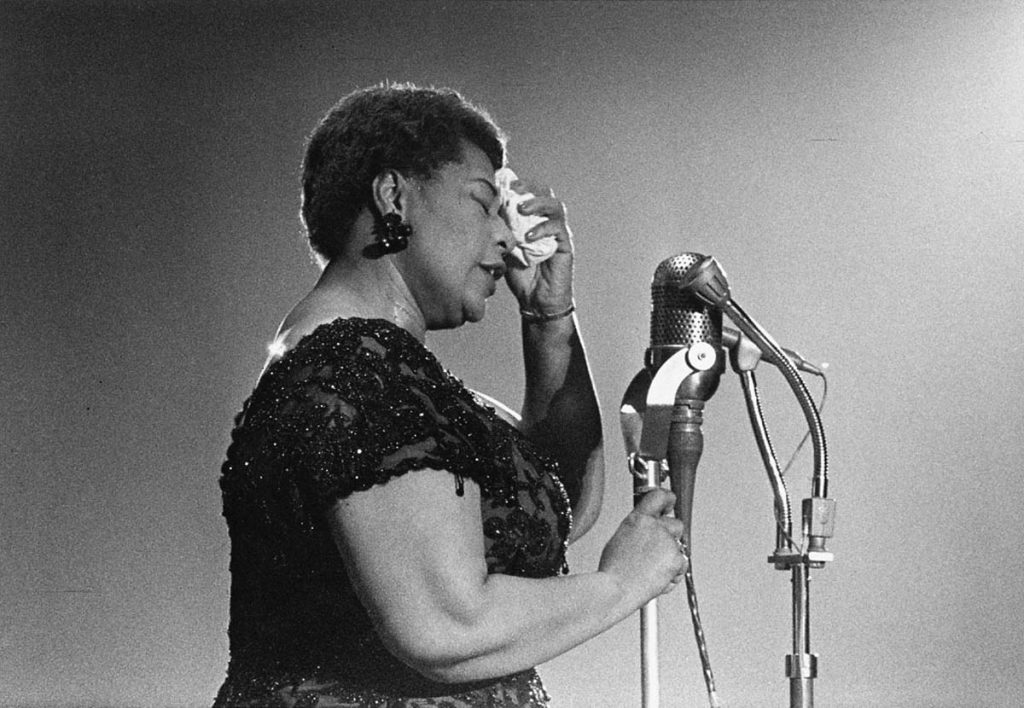
A few weeks ago, the American music, pop and rock magazine Rolling Stone published a list of the most important 200 singers of all time. This compilation was hotly debated; some decisions are understandable. The great voices of African-American music history are honoured; Aretha Franklin – certainly not without good reason – comes in at number one. Meanwhile, many in the online forums protested with the same justification about the 45th place: Ella Fitzgerald, born in 1918 in Newport News (Virginia), found herself there. An absurdity considering the fact that Fitzgerald’s voice shaped the first half of the 20th century like no other.
Mary Lou Williams, herself one of the most important composers of jazz and the Great American Songbook, once recounted a night of dancing in Harlem’s Savoy Ballroom. “A voice that sent a shiver up and down my spine.” Further, it is said of her that she even literally ran to the stage to find out who the voice belonged to.
Of course it was Ella Fitzgerald, the band to Chick Webb’s swing band. Chick Webb, the influential swing band leader at the time, discovered Fitzgerald in 1934 at a singing contest at the Apollo; also located in Harlem. The legendary club boasts to this day that it was the place where “Ella” was discovered. At least that’s how the legend has it.
In fact, Webb did not meet Fitzgerald, who was often shy in the early days, until a year later; and was only to hire her permanently after a few months of rehearsals.
Nevertheless, she quickly convinced with her youthful voice, which even decades later sounded as if the vocal chords had fallen into a fountain of youth or had made a deal with the devil. As evidenced, for example, by this recording from 1968 – when she was already 50 years old – of the Gershwin ballad “Summertime”:
This version sounds familiar to you, dear readers? It’s a familiar phenomenon in the context of Fitzgerald’s career. As the most important interpreter of countless compositions – fuelled, incidentally, by her involvement with the Verve label, for which she has recorded several songbooks – one could claim that Fitzgerald “owns” these songs. In any case, her interpretations continue to shape the songs to this day.
With Chick Webb, she was to lead the swing that made the States dance and sing in the pre-World War II era. After Webb’s death in 1939, she took over his band for a few months, which unfortunately didn’t work out: as a self-taught musician, she had never learned to read music and was comparatively unsuitable as an arranger. Before death, Webb, Fitzgerald and the band had a number one hit on the Billboard charts. “A Tisket A Tasket” was the big breakthrough.
Although her voice was inspiring and as much as she enchanted the audience with her youthful manner, one particular technique could be particularly significant in the big picture of music history: Fitzgerald raised scat vocalisation, which was in any case very important in the emancipation of the voice as an instrument in its own right, to a new level.
Carmen Lundy explains in Joachim-Ernst Berendt’s “Das Jazz-Buch”: “Many scat singers use the syllable dwee very often. Ella Fitzgerald, on the other hand, does not use dwee very often. She uses the bee-bop-bop-bah-ooo-bee-doo-bee more.”
This richness of form and variety of sounds was extremely important. Scat, which here emulates, among other things, the saxophone, which is quite related in sound, goes from being a gap filler to a complex system of different sound components.
You can see that here, for example:
This made Fitzgerald the most important vocalist in be-bop, as she was better able than most of her colleagues to meet the new demands for harmony and vocal improvisation. The rest is history: In the course of the 50s, she became known to a wider audience – despite segregation in the southern states and performance bans. Marilyn Monroe also played a part in this, but above all her wonderful timbre, which opened eyes and mouths throughout her life.
And as already mentioned: Fitzgerald collected songs through her iconic interpretations like other people collect stamps. After an eventful career, she died in Los Angeles in 1996 – showered with honours and medals. Perhaps the editors of Rolling Stone should reconsider the placement in their Top 200.
Text: Lars Fleischmann, Foto: Foto Ben van Meerendonk / AHF, collectie IISG, Amsterdam
In a city full of terrific pianists, Felix Hauptmann, a native of the Saarland, has been able to carve out a prominent role for himself. A conversation about his band Percussion.
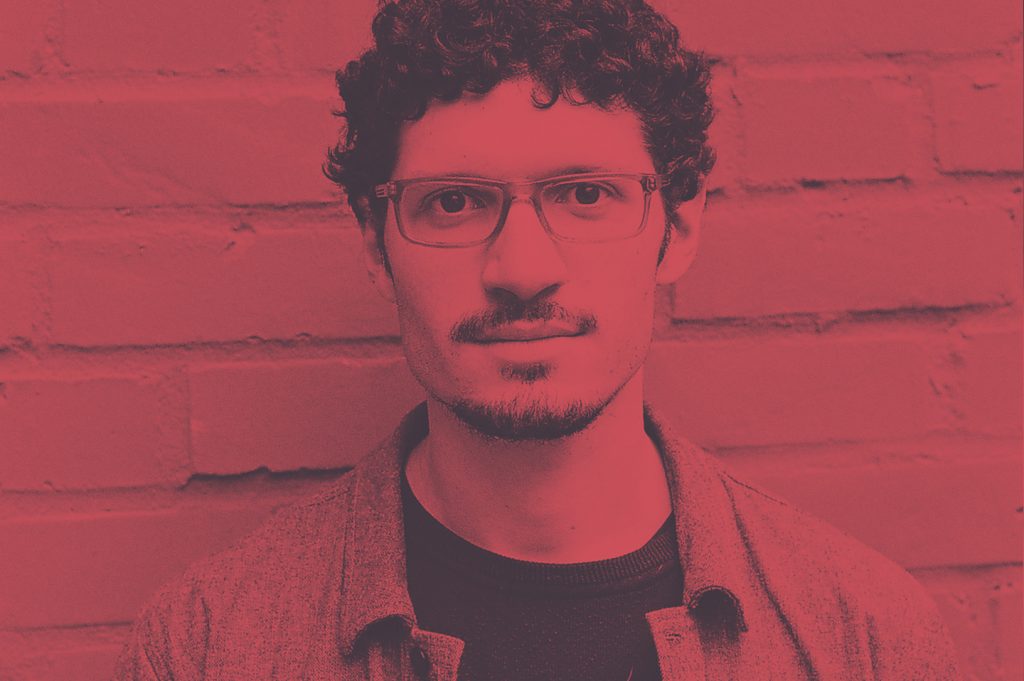
The winner of the Horst and Gretl Will Scholarship for Improvised Music of the City of Cologne 2022 is a highly active part of the local scene – as composer, musician, lecturer and organizer. The jury’s statement reads: »As a pianist, he is a clairaudient sideman; as a soloist and composer, he works emphatically and creatively to find and invent his own paths. His compositional handwriting is marked by an astonishing familiarity with compositional styles of contemporary serious music, […]« This versatility has characterized Hauptmann for several years – he came to Cologne to study at the Hochschule für Musik und Tanz back in 2012 – and is reflected in his own music, which does not merely function according to dictates or maxims, but is in a constant process of change.
Last December he played with his band Percussion – with Roger Kintopf on double bass and Leif Berger on drums – at the King Georg.
Your professional career began very early. You made your first mark with the HNK Trio, when you were far from being of age. How did that come about?
This connection came about through my (jazz) piano teacher from Saarland at the time, Christoph (»Sunny«, author’s note) Mudrich, who was very well connected. He gave a lot of workshops and taught a lot, so he knew a lot of (hobby) musicians. When he realized that this could go in a certain, more professional direction with me, he looked around in Saarland for people with whom I could form a band. He then found Conrad (Noll) and Fabian (Künzer). When we realized that we didn’t only want to play standards, but also write something ourselves, the band started to work. That’s when I was 16 when it got more serious.
In 2011 you won the studio award of the Deutschlandfunk. Does that make you feel like a prodigy?
No, I never felt like a child prodigy. It was much too weird for that. The competition was in Dortmund and that was the first competition I played. I hate auditions and competitions – at least today. But at that time we were there because there was no other applicant from the Saarland. It was »either you go or nobody goes«. When we arrived there, without an audition or anything like that, and heard the level at which they were playing, it was clear to us: there’s nothing to be gained there. Some of the other bands were already older, some were already studying. We were very happy when we actually won.
But that didn’t make me feel outstanding now. I was always very supported, which is super nice. Nevertheless, I never felt like a prodigy.
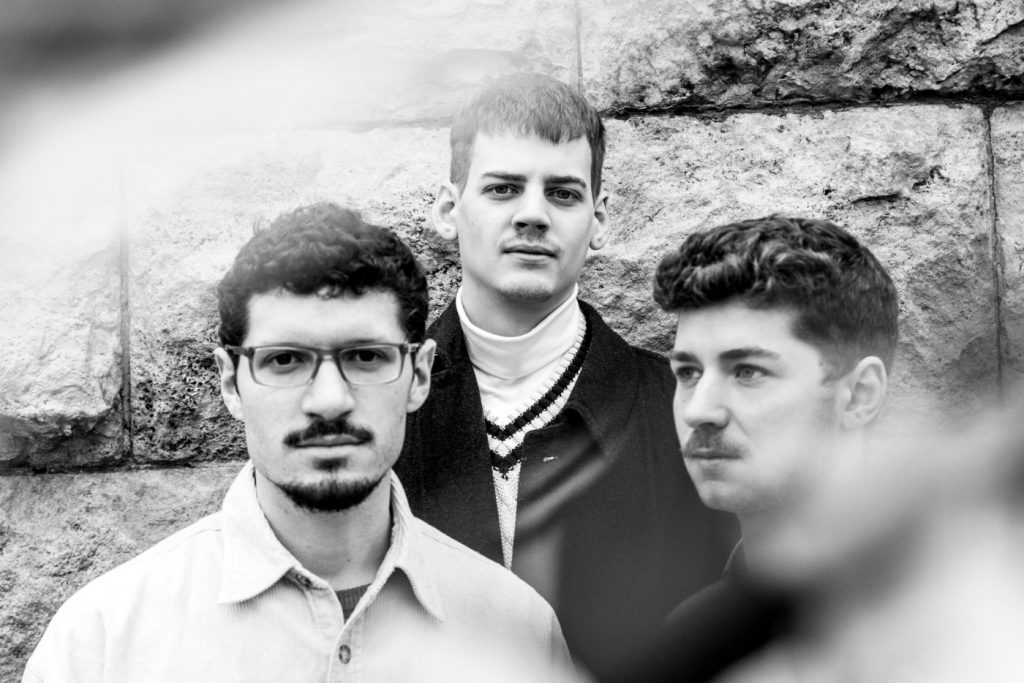
Your instrument, if we take it as a pianoforte, it’s probably the most widespread or well-known instrument in the world …
… in the western world …
… exactly, the western world its the 1830s. But that’s when it influenced music the most with the guitar. That’s why it’s the best studied, it was all done on it, I would argue. Is this inherent heritage fundamental to your work as a pianist?
For me it means a certain freedom, that everything has already been played, every connection and every chord has already been played. I don’t know that much music, compared to other people, but I have a certain certainty that really everything has been played before. It doesn’t have to have seen the light of day in a big way or to have arrived here, in Germany – for me, this doesn’t mean that I have to create something “new”. That’s not what it’s about for me. If I don’t have to reinvent the wheel anyway, then I can concentrate on what I want to play and explore.
It’s different, for example, when an instrument is played on stage that you don’t know here: there you are first occupied with the sound and perhaps not so much with what is being played.
Nevertheless, you try to expand the vocabulary of keyboard instruments. You also devote yourself to analog synthesis. That’s what it says in the justification for the Cologne Horst and Gretl Will scholarship…
Well, I am partially dedicated to analog synthesis. I find it a bit amusing that this is the first thing mentioned there. There are colleagues who have already devoted much more time to it. For me, I wouldn’t say that I »deal« with it.
I use the synthesizer and just last week I did a synthesizer session with my band Percussion, but that’s about it.
Therefore, there is an album of mine, »bloom (night)«, which I recorded at home with synthesizers. But that’s also only on Bandcamp and never released in a big way.
I wonder if you are in the process of resolving (for yourself) certain dead ends in jazz and improvised music played on the piano.
These dead ends are not on the instrument, but if on me.
And yet, with your band Percussion, you clearly dedicate yourself to rhythm, which is the new field of research in music, after harmonics has been taken to extremes in recent years and seems to have been formulated.
Yes. That’s the basic idea, of course. The name Percussion is also on the nose. It came out of pieces that I had done once and then just called »Percussion 1« etc.. After I put out »Talk«, it was a nice moment. I was very satisfied and yet I could say that I don’t like to play this music anymore for the time being.
What gave rise to this feeling?
When you study piano in Cologne, you really have to have checked out everything. The level is extremely high. And especially when it comes to harmonics, there is a subtle pressure that you feel during your studies. But then I wanted to do something else at some point. And the fastest and most interesting alternative to that was rhythm. I’m a fan anyway: if it doesn’t groove, then it’s garbage anyway …
And after a conversation with Leif (Berger, drummer with Percussion) on the train, where we talked about Cologne and the level in the city, it was clear: harmony then ultimately remains a limited field in the twelve-tone system. And rhythm is unlimited. Leif said that he found it strange how little focus there was on it. That was the trigger to go deeper with rhythm.
What is the idea with percussion?
Basically, the way we play is based on the pieces alone. We played 11 or 12 pieces the Thursday we played at King George. You might not think so, but we primarily play pieces, even if they sound free. We have an extremely large amount of material. There are improvised passages, but the majority is composed.
That’s actually surprising. Because the three of you seem very free in the way you play….
Because we learned it by heart. That’s a big point. Learning the material took forever because it’s so extensive. This is by far the band I’ve rehearsed the most with. When we play a gig – aside from touring now – we have to meet again before every show.
That’s the core of this project for me: the music is obviously very complicated, but the complexity is not an end in itself, it’s just a vehicle for a working band. I wanted to have a reason to rehearse a lot.
I always think: the music is so weird and difficult that you feel like you’re in your first garage band, trying to cover pop songs even though you didn’t know how to turn on the keyboard. And then you create that on top of it. And that’s the vibe that percussion is for me.
But that also means putting a lot into it …
Yes, exactly. Sometimes there are such snooty things. You say a composition is »crap« when you don’t feel like playing a piece after a rehearsal. I think that with the privileges we enjoy here, there has to be something more behind it. I can no longer approach making music along the lines of, »I can play anything anyway, and I’ll just leave something I don’t like.« Percussion is the opposite: the compositions have to be worked out.
I’m no longer into this »you come somewhere and then you play something away«. I come from there, but it doesn’t make sense to me or the band anymore. I felt less and less comfortable with living in a country like Germany and everything is easy for me, I don’t have any existential worries, and then to sit down and gamble. That’s not sustainable, where is that going.
That’s very anti-genialistic and anti-romantic.
Yeah, that’s a good thing. I’m really glad that the band members in Percussion, but also the musicians in the other constellations in which I play and work, see it the same way. There’s a lot of rehearsing and talking, reflecting and doubting.
You are a lecturer in Wuppertal at the Bergische Hochschule … What do you teach your students?
I can’t »teach« the students much anyway. Even though my teaching assignment is called »jazz piano«, I teach in the teaching program. So I don’t teach aspiring professional musicians, but those who want to teach in schools themselves later. In the fewest cases, it’s about playing jazz piano. It’s more about concrete things: How can I arrange a song? How do I accompany students when they want to try something different from the curriculum? For me, it’s about conveying a basic flexibility. I see myself more as someone who provides assistance.
Do you take anything with you for your own music and compositions?
Not so far. That’s because I’ve been working on my music for a very long time and it’s far away from what the students themselves are interested in now. But I still benefit from the fact that I have already thought so much about music and my music – whatever that means in detail. What already happens: I hear songs that I didn’t know but think are cool. I take that with me. And I see and hear what the even younger people are interested in, what problems they face in the subject and in general … these are future teachers and I get an insight into how the course is designed and what will be taught soon. I try to take that with me …
Interview: Lars Fleischmann.
Bandleader, composer and vocalist Nicola Missing plays with Quintett at King Georg. We talked to her about training in Maastricht, jazz and pop.

That there are also formidable »young talents« outside of German universities, colleges and conservatories does not need to be told at length; nevertheless, it is a happy occasion to be able to welcome one or more such talents from the distant Netherlands at the end of the year. Band leader, composer and vocalist Nicola Missing is a native of Koblenz; she says “born and raised in Rhineland-Palatinate”. From the Deutsches Eck (and at 23 at the time), she went to Maastricht Conservatory two years ago to study jazz vocals. There she met Jakob Lingen (now on drums) and Peter Willems (bass). She “hired” the rhythm section for her Nicola Missing Quartet. A few months ago they went on to Amsterdam to the local conservatory. There the pianist Chris Muller and Jeline Weening on saxophone appeared on the scene. The quartet became a quintet at King Georg.
How did you get into jazz singing?
I started playing the piano when I was five and I had singing lessons from the age of nine. In my youth, I mainly sang pop vocals, but then I also sang R&B. The bridge to jazz was relatively short.
Later, I did the one-year preliminary studies at the Open Jazz House School in Cologne – and after the entrance exam, I decided to go to Maastricht.
What brought you to Maastricht?
Maastricht is one of the nine renowned conservatories in the Netherlands, but from Koblenz, for example, the way to Cologne would have been closer …
First of all, I already knew people who studied in Maastricht. And besides, it was important to me that I wanted to study in a smaller city first. I wanted to study more inwardly, so I wasn’t interested in a particularly exciting city or a larger scene with lots of sessions. I really wanted to focus on studying and my own songwriting.
That’s an approach that I don’t think is taken that often. Is that something you would recommend to others?
For me it was a good decision.
You also decided against German universities and conservatories and preferred the internationality. How much has that influenced your studies so far?
In a very positive way. It is definitely more challenging than studying in German in Germany. But I like that. I also find it easier to express myself in English, which is the working language here. There are many more ways of describing things and more terminology that is also understood internationally. I find it very helpful to be able to communicate across borders.
The percentage of Dutch students is much lower than the international students. For me it’s even better, because I … I say: I study with one foot in the Netherlands, but one toe sticks out into the German scene.
For you as a vocalist, it’s probably even more interesting, because you’re probably not confronted with German intonation and articulation in English, which is the predominant vocal language, but with international ones.
That is actually very interesting. In technique and interpretation I have two Dutch lecturers, both of them have quite a strong accent. Here in Amsterdam, in the Jazz Vocal Department, I have a course at the same time called “English/American Pronunciation” with a US-American. So, funnily enough, I have this Dutch input, as well as this work on phonetics and articulation
Does that also change your relationship to English as the language of jazz standards?
Yes, definitely.
You also sent me a concert recording. Among other things, you interpret the Michael Jackson classic »I Can’t Help It«. This one, as you know, is co-written by Stevie Wonder. Wonder is an ardent fan of jazz. How do pop (Michael Jackson) and jazz (parts of the melody line here, for example) relate to each other for you?
I have a hard time with genre terms. For me, the attraction lies in not being able to precisely demarcate the boundary between jazz and pop. That said, I’ve been interested in jazz vocals above all else for a few years now. For me, pop chords are usually not enough; I want to express myself more and in a more multifaceted way.
Who are your idols?
You already mentioned one: Stevie Wonder. I think it’s very cool how he has one foot in pop and one foot in jazz. But I also find many traditional and modern jazz composers and musicians attractive in their work: Coltrane, Esperanza Spalding, Brad Mehldau, Betty Carter, Veronica Swift.
We were just talking about the fact that you chose Maastricht to be a bit more “secluded”. I think you have a very good overview of the standards and different interpretations. Is that the result of that time you invested?
For me it’s important to have and develop a jazz-historical overview. For me it’s helpful to hear as many versions of a song as possible to really dive deep into the song. And also to let myself be influenced by different styles and stylistics. Then you can also playfully deal with the material.
What does that look like with your own compositions?
The piano is the basis in all songs. But I never sit down to it with a certain intention and try to compulsively make something new. Mostly the harmonies come first, then the lyrics and then the melodies.
Actually, you wanted to perform in Cologne with your quartet …
Exactly. I formed the quartet here in Maastricht: With a pianist, a drummer and a bass player. I started composing a lot during Corona and the three of them were optimal to realize my compositions and what I had in mind.
And now you perform with a quintet …
There were two changes. I’m performing at King George with a new pianist – and above all with a saxophonist. I feel that stylistically they fit very well with my compositions.
How does the approach change for you with the formations?
For me, the quartet is the smallest unit for my music. I also perform in duos, but I think the balance in the quartet is optimal: there is enough space for everyone and my voice. The ratio of rhythm and melody/harmony is also right. At the same time, I find it exciting now in the quintet that the saxophone opens up completely new possibilities. I like it when instrument and voice play in unison. It’s also appealing to explore again the blending relationship between voice (for the text) and voice as instrument. The saxophone helps to make my voice sound different. It’s no longer just “singer with band”. It is then increasingly about other colors, about second voices, about more complex harmonics.
Is the concert at King Georg then also an opportunity to try things out?
Yes, in several ways. It’s the first performance with the band outside of school. And you don’t study to play at school, but in front of an audience. The performance is the purpose of my studies. I’m also interested in the changed reception behavior. Where you don’t just play and listen to the songs in critical analysis and with content-related criticism, but just for pleasure.
In addition, we have never played together in this quintet version. So it is an attempt. I am curious mysel
Interview: Lars Fleischmann
The composer and saxophonist plays jazz with a lot of funk and soul and develops a drive that brings together big-city, upbeat and evening moods.
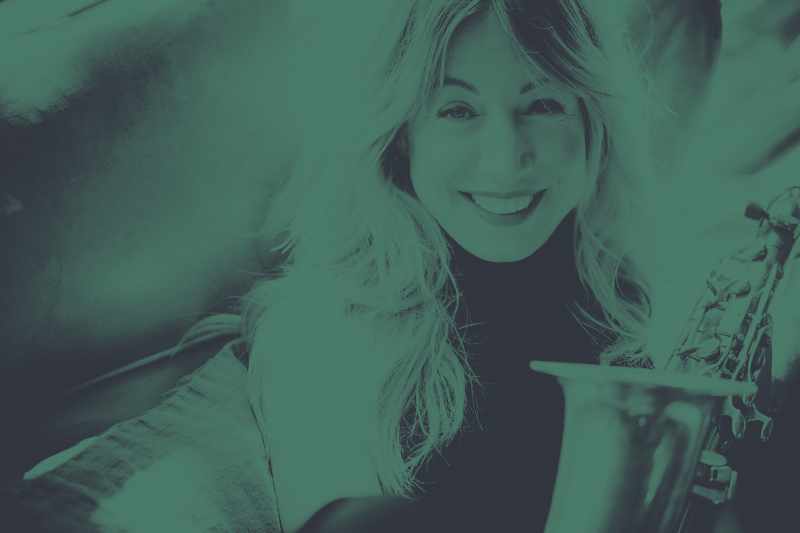
Even under optimal conditions, it takes a full nine hours to get from Wolfratshausen to Hamburg. For Stephanie Lottermoser, who was born in 1983 in a small Bavarian town south of Munich, it took a little longer before she was drawn to the Hanseatic city on the Elbe in 2018.
Before that, there were piano and singing lessons as a child, and later the switch to the saxophone and the big band line-up in school days. Soon the tranquil town of Wolfratshausen, known above all for having exploded in 1734 after being struck by lightning, was to become too small and Lottermoser went to study in Munich. From then on she studied cultural studies at the Ludwig-Maximilians-University in Munich, as well as music at the University of Music and Theatre. The additional education in the humanities also sets her apart from some of her colleagues, and Lottermoser is considered one of the most reflective musicians on the German jazz scene – as she regularly demonstrates in the podcast “Jazz Moves Schnack” together with jazz journalist Jan Paersch, among other things. Lottermoser’s view is an analytical one, one that nevertheless also includes extra-musical references and thus presents exciting perspectives and points of view.
This can also be seen in her own music, which she now presents to a wider audience since 2008 and the formation of her band “Resonance”. Lottermoser’s jazz playing is clearly influenced by funk and soul, but remains clearly rooted in the field of (groove) jazz.
As precise and meticulous as their view of music is, as lively, entertaining and danceable are their own compositions at the same time. Just on their last longplayer “Hamburg” (ihr upcoming “In-Dependence” will be released on Nov. 21. presented at the King George) one could convince oneself of how skillfully and skilfully Lottermoser composes: In long movements and in elegant solos she sails here through different genre, crosses quite sometimes poppier ways and then gets back again and again via a thorough consolidation. On this breathtaking “harbor tour” we are invited as listeners, sail across the halfway tamed sea, let ourselves be carried along and moved by a few waves and come ashore dry-footed again in Altona.
Grandiose support comes from their crew: Maik Schott (keyboards), Robert Schulenburg (bass) and Tobias Held (drums), who together with Lottermoser keep the pieces on course. Thereby, daring turning maneuvers are definitely possible, but just not used as a standard effect. In her music, the Hamburg-born artist manages the feat that even Stevie Wonder succeeds in in his musical field: the straightness of her own sound makes it possible to incorporate decorative elements again and again without seeming kitschy or even volatile.
Quite the opposite: Stephanie Lottermoser always presents herself as a nimble saxophonist and composer who can bring together big-city, up-and-coming, and evening moods – and everything seems to be cast from a single mold.
This drive, which comes across as unpretentious, clear and without frills, therefore also moves body and mind; finger snapping and foot tapping are guaranteed when the quartet gets going. The finely balanced harmonies then accompany the head through the boulevards on the banks of the Elbe, the hustle and bustle of the Sunday fish market, the large Reeperbahn and the small boats on the Alster. A declaration of love as only a sharp, precise composer with an unblinking eye can make.
Text: Lars Fleischmann
Surya Botofasina, Nate Mercereau and Carlos Niño invite you to a journey into other spheres.
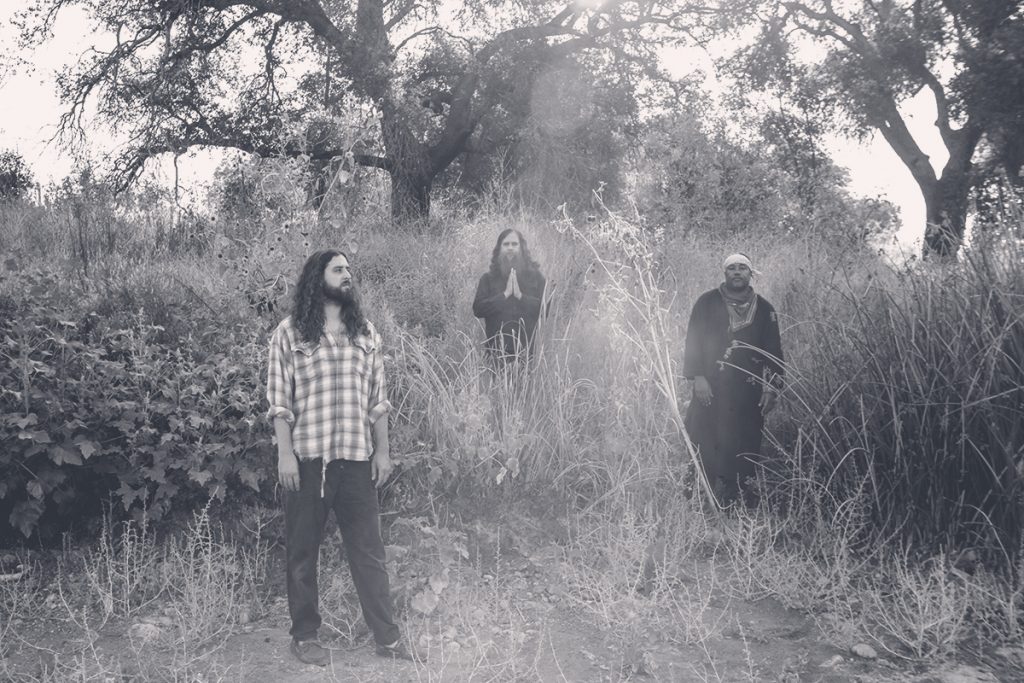
Find a balance between the sound and your ego – this is how Surya Botofasina describes his rule for improvisation. As tangible as this advice is, the California-born jazz pianist and synthesizer player usually speaks in flowery terms. When he talks about music, it is often about the idea of universal love, OneLove, which is expressed and spread in life and in music. It is also about sounds that are just waiting to be discovered in the cosmos. And it’s about pianos whose destiny is to be played at some point. The earthly and supernatural course, the physics of sound production and the metaphysics of a “hidden” actual melody, exotericism and esotericism – always the son of the Afro-Cuban harpist Radha Renee Reyes-Botofasina finds himself between the extremes.
Don’t think … play!
You can’t really hear that in his music, you have to realize pretty quickly. Especially on his latest album “Everyone’s Children” everything seems to be in flux; one hears little of conflicting approaches or philosophies, but rather his origins and the contexts in which Surya Botofasina grew up. In 1977, he was born at the Sai Anantam Ashram in Northern California. His mother was – one would say today – spiritually inclined. In the early 1980s, the family moved to Agoura Hills to the ashram that Alice Coltrane had just formed and built. There, first Radha Renee Reyes-Botofasina became a disciple of Coltrane, who in the meantime had risen to medium and guru, and who from then on was only called Swamini Turiyasangitananda, and some time later also her son Surya. However, one cannot really speak of teacher-disciple relationship, because Swamini Turiyasangitananda does not teach, instead she inoculates a feeling: “While I was rehearsing, she just dropped the chords. A major, G minor … She told me not to think, but to play.” Not the only lesson that resonates to this day. Likewise, people regularly sang bhajans, Vedic verses in chant form. Of course, one was in an ashram.
The contact with these mostly simple, spiritual and transcendent songs can be heard sometimes even now. “Everyone’s Children” has been released these days by Spiritmuse: There are eight tracks on the double LP. The shortest ones last a little more than four minutes, the longest track “Surya Meditation” lasts almost 30 minutes and exhausts the technical possibilities of the vinyl production.
As delicate as possible
The music, on the other hand, is more restrained. Instead of bombast, meditative journeys to the center of the earth and to one’s own self await: Botofasina mostly plays naive, spontaneous melodies, intuitive tone sequences and arpeggios. Underneath lies a carpet of organic organ sounds – sailing weightlessly between Vangelis and Laraaji. Carlos Niño appears here as co-producer and constant companion. The Californian with Hispanic roots made his name as a radio DJ in the 1990s, then later began studying percussion instruments. Niño is currently considered one of the most sought-after percussionists on the American and international jazz scene and is a welcome guest on European (festival) stages, where he has been omnipresent in recent years, and quite rightly so. His art is to play as little percussion as possible. Delicately stroked, careful chimes then meet slow-flowing rainmakers; echoed bells meet shakers – especially on “Everyone’s Children” it’s never really about a beat, but about sonic underpinnings for the bell-like piano runs.
Enriching sounds
More classical jazz sounds can be found as well: Especially in the piece “Beloved California Temple”, which seems very modern with its strong use of reverb, but still follows old ideas of Pharoah Sanders. In addition to Pablo Calogero on saxophone, Nate Mercereau will also shine here – the third in the group at the concert in King George on November 17, 2022.
Mercereau is a truly gifted guitarist and songwriter who, in addition to his own projects, performs primarily as a sideman: his credits now range from American pop superstars Lizzo and The Weeknd to jazz starlet John Baptiste.
With them, but also with Surya Botofasina, he performs regularly. For “Everyone’s Children” he devoted himself to the spiritual journey and plays only a few necessary, enriching sounds, noises. On this album, everyone has committed themselves to balance and put their egos aside. Just as the bandleader exemplifies.
Text: Lars Fleischmann
The saxophonist Muriel Grossmann starts late – but right! We recap her musical career – and what her music has in common with that of John Coltrane.
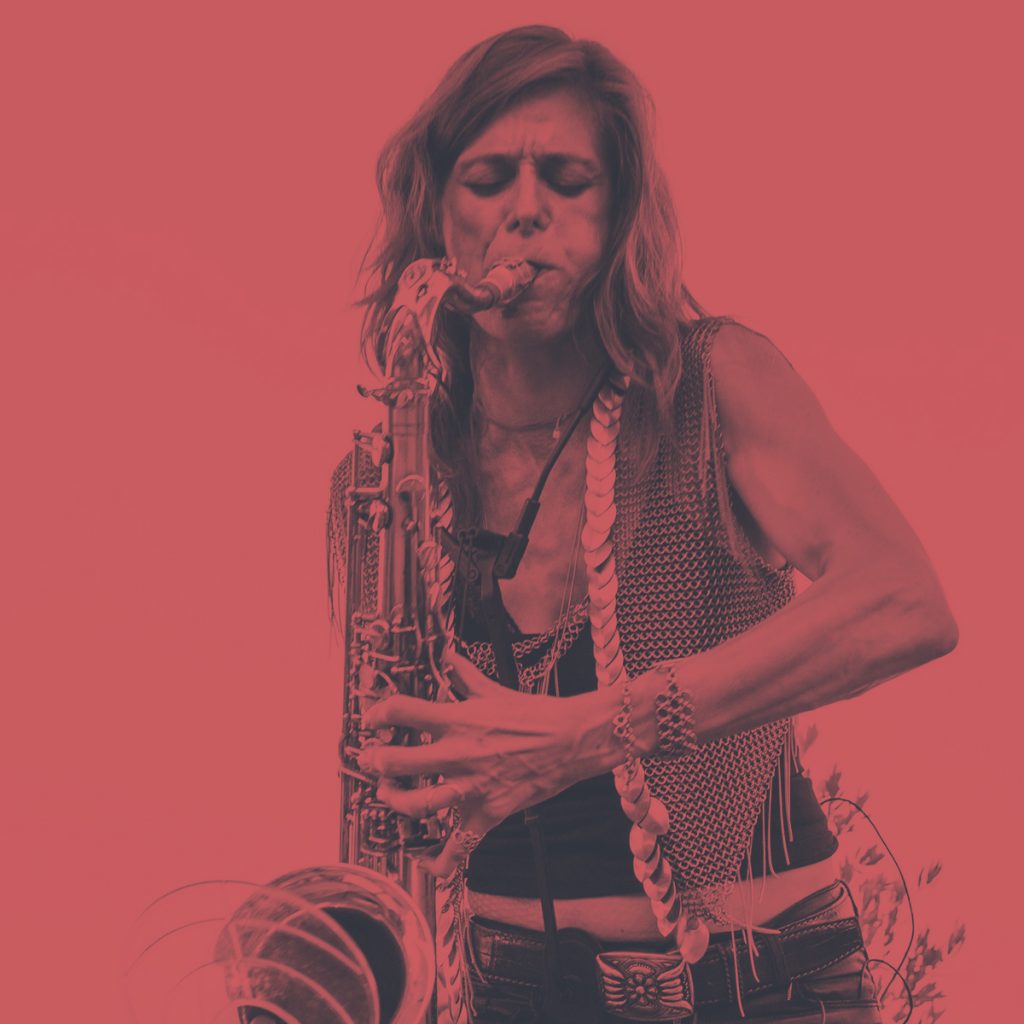
Twenty-five years ago, no one would have guessed that Muriel Grossmann (who was born in Paris in 1971 and will play two sets at King George on Nov. 11, 2022) is one of the most important jazz saxophonists today. Grossmann’s career would actually have looked different if it were still up to young Muriel today. After moving to Vienna with her family in 1976, attending various schools and taking her Matura, she originally wanted to become a veterinarian.
Study overboard
Although she had already spent several years with the flute at that point, it didn’t really spark. It was only when she switched to the saxophone at the age of 21 that her plans changed: she threw her bourgeois studies overboard and devoted herself to music. Years of commuting followed: between rhythm’n’blues, funk and jazz bands. No sooner than 2002, when she became based in Barcelona, a serious jazz career crystallized. On the advice of the pianist and composer Joachim Kühn, with whom she had already played frequently, she moved to the Balearic island of Ibiza in 2004. There she met Niko Weaver, guitarist for Prince for years, joined his band, at the same time still playing in hotel bars. In addition, she built up her own group. There was more than just one year in which Grossmann played 180 concerts. Nevertheless she found the time from 2007 even to build up her own label (“Dreamlandrecords”), to record and produce her own LPs. Finally, at the age of 36, the breakthrough followed.
Starting comparatively late, as Muriel Grossmann did, is not a disadvantage, especially in jazz; John Coltrane also developed leisurely into an ace and was only able to make bigger waves as part of the Miles Davis Quintet. But that is not the only parallel between the Methodist son from North Carolina and the Austrian teacher’s daughter. Anyone who listens to Grossmann’s compositions will immediately notice that they are clearly inspired by Coltrane’s “Impulse!” phase. It is the period from 1961 on, when the African-American tenor saxophonist had already achieved world fame, but above all developed artistically and stylistically, as a result of which he found freer forms. Especially his investigations into the African origins of jazz and the spiritual qualities of the hotly and intimately, exhaustively loved music, find a delicate echo in Grossmann’s music 60 years later.
Then one rediscovers Coltrane’s lightness – an often underrated class – in the Austrian’s sultry compositions and vigorous playing. At the same time, she shows inspiration from works by composer Alice Coltrane, John’s second wife, and pianist McCoy Tyner. These influences can be explored, for example, on their Jazzman compilation “Elevation”. Especially with “Peace For All”, “Rising” or “Chant” you can hear inspiring sounds, which by the way do not exhaust themselves in epigonism, but weave in current references.
Again and again, rich soul, warm jazz virtuosity and the dignified view into the past penetrate to the surface, are given room to breathe there. A sound that melts into a dream, making the transitions smooth and fertile at the same time. Those who fear arbitrariness must be reassured: very charmingly, with a fine pen, Grossmann always leaves room where condensation would be excessive. The phrasings sound loose and concentrated at the same time.
The full range then shows itself again in a piece like “Quiet Earth” from the LP of the same name, which with its oil painting and impasto paint application almost seems like a construction manual for the title track.
There is the rich red and the warm orange that spread out when Grossmann and her fellow musicians (among them the long-term collaborators Gina Schwarz on bass and Radomir Milojkovic on guitar) definitely go into a clinch with “Olé” and “Africa/Brass”; the dry blue that presents itself here as a fusion influence or also the white ground that celebrates itself in Uros Stamenkovic’s playing.
Text: Lars Fleischmann
On the occasion of the concert of the Tribute to Cole Porter Band with Klara Schwabe, Till Marschewski, Marcus Demel, Dominik Meyer and Sarah Mysegaes: The story of a not always happy life full of immortal songs.
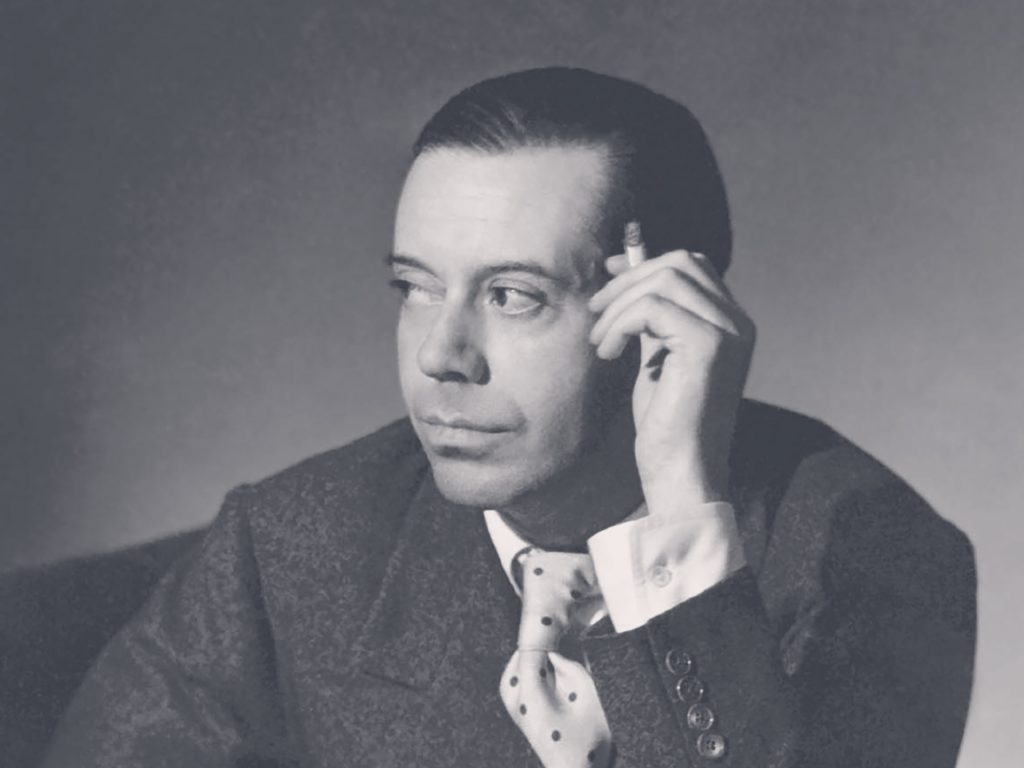
When Klara Schwabe, Till Marschewski, Marcus Demel, Dominik Meyer and Sarah Mysegaes pay tribute to American songwriter Cole Porter on Wednesday, September 28 , you can look forward to wonderful, upbeat pieces from the classic American Songbook. Porter takes a prominent role because his personal resume and professional career diverge widely.
Porter was born in 1891 in Peru, Indiana, USA, into wealthy circumstances. There he learned to play the violin at the age of six, and the piano from the age of eight. As early as 1900, just in time for the turn of the century and his ninth birthday, he worked on his first own pieces.
Europe as a new home
At 14, it’s off to an academy in Massachusetts, at 18 to Yale University in New Haven, Connecticut, again four years later to Harvard. According to his family’s will, he was to become a lawyer, but he himself preferred music, dropped out of law school and soon studied composition. However, his studies were abruptly interrupted by the First World War: a momentous decision took him to the French front. But unlike his peers, for whom wounding or even death awaited, for him it was Paris and its cultural life that changed him permanently. He remained in Europe after the end of the war, tossing and turning his evenings and nights, and met his future wife, Linda Thomas.
Crutches as constant companions
After a tidy inheritance, he was well provided for anyway. This gave him enough time to get one, two, three, four feet in the door, first in Europe and then again in the USA. From then on he wrote for groups, big bands, theater, musicals. The friendship with Irving Berlin was the door opener, if it ever took longer. But the name Porter had long had its own luster. Glory was not only to await in the performance arts; film, which had just acquired soundtracks, became another playing field.
For Hollywood, Porter composed, among other things, the immortal classic “Anything Goes.”
A year after the success of “Anything Goes,” Porter’s life would change forever – not for the better. After a fulminant riding accident his legs are badly injured; the doctors want to amputate, Porter refuses the measure: he did not want to give up playing the piano. The conservative treatment method did not cost him his life, but his strength was never to return – despite several operations. Crutches and a wheelchair became constant companions.
A musical as a huge success
He still had plenty in his quiver: after the horrors of World War II, American society is intent on hedonism and drifting away. The Broadway musical “Kiss Me, Kate” is taking the country by storm. Music and lyrics by Cole Porter, of course.
Five years later, the next stroke of fate: his mother died in 1952; less than 20 months later, his wife Linda also died. The two women had been the great trusted figures of his life, although at the same time he made comparably little secret of his homosexuality. After that, Porter was a broken man.
Artistic footprints like craters
The situation around his legs changed abruptly, the amputation could no longer be prevented. After years of agony, he died in Santa Monica in 1964. His legacy, his musical one, nevertheless cannot be erased from America’s history. His footprints deep craters full of songs, hits, popular songs. “Night and Day” and “Cheek to Cheek” are two of the most famous songs of the 20th century. Standard repertoire for all crooners and entertainers; for Juilliard School aspirants as well as Frank Sinatra and Dean Martin.
Text: Lars Fleischmann